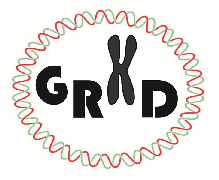Center for Gene Regulation in Health and Disease (GRHD)
Mailing Address
Center for Gene Regulation in Health and Disease (GRHD)
2121 Euclid Avenue, SR 259
Cleveland, OH 44115
Campus Location
2351 Euclid Avenue
Science and Research Building, Room 259
Phone: (216) 687-2516
Fax: (216) 687-5549

Dr. Bibo Li
Telomeres are nucleoprotein complexes located at chromosome ends. Although telomeres do not contain any genes, they play a pivotal role in protecting the natural chromosome ends from illegitimate DNA recombination, repair, and nucleolytic activities. Therefore, telomeres are essential for genome integrity and chromosome stability (which is important for preventing tumorigenesis in humans). Conventional DNA polymerases cannot fully replicate the ends of linear DNA molecules, leading to progressive telomere shortening in proliferating cells, causing the so-called "end replication problem" (which is an important cellular senescence mechanism in human somatic cells and has been implicated in organismal aging). Most eukaryotes use a specialized reverse transcriptase, telomerase, to synthesize the telomeric DNA de novo, which helps maintain a stable telomere length homeostasis. The core telomerase enzyme contains a catalytic protein subunit (TERT) and an RNA subunit (TR) that provides a short template for the telomeric DNA synthesis. Telomere maintenance mechanisms are essential for unlimited cell proliferation. In addition, telomeres often form a heterochromatic structure that suppresses the expression of genes located at subtelomeric regions, a phenomenon termed telomeric silencing. Furthermore, telomeric and subtelomeric regions are frequently fragile sites that experience relatively more frequent DNA recombination than most chromosome internal regions. Interestingly, in quite a few microbial pathogens that undergo antigenic variation, genes encoding the major surface antigens that are essential for the pathogen’s virulence are located at subtelomeric regions, presumably taking advantage of the plastic nature of the subtelomere.
My lab is interested in studying telomere functions in Trypanosoma brucei, a protozoan parasite that causes African trypanosomiasis in humans and livestock, which is frequently fatal without treatment. T. brucei regularly switches its major surface antigens (VSGs) to evade its mammalian host’s immune response. This antigenic variation is critical for T. brucei to establish a long-term infection. All VSG genes are located at subtelomeric loci, and VSGs are exclusively expressed from telomere-adjacent VSG expression sites in a strictly monoallelic manner. Our lab has demonstrated that T. brucei telomere proteins not only are essential for cell proliferation but also suppress VSG switching and are essential for VSG monoallelic expression. We have found that T. brucei RAP1, an essential telomere protein, is a key regulator of VSG monoallelic expression. We have also found that many telomere proteins help maintain the telomere integrity and suppress telomeric and subtelomeric DNA recombination. Interestingly, we have found that T. brucei TRF and RAP1 both bind the duplex telomeric DNA, although using very different binding mechanisms, and both help maintain the telomere integrity by suppressing the level of telomeric repeat containing RNA (TERRA) and the telomeric R-loop level. In contrast, PolIE, an essential telomere protein and an A family DNA polymerase, helps maintain the telomere integrity by coordinating the telomere G- and C-strand syntheses. We are currently investigating the underlying mechanisms of how telomere proteins maintain the telomere integrity and stability and how T. brucei RAP1 regulate VSG monoallelic expression.
We are also investigating the interaction between TERT and TR and its role in telomerase-mediated telomere maintenance in T. brucei.
Additionally, we are collaborating with Dr. Bin Su in the Chemistry Department at Cleveland State University to develope small compounds that specifically inhibits T. brucei growth without affecting its mammalian host. Our work has resulted in identification of several lead compounds that can inhibit T. brucei growth effectively both in vitro and in vivo.

Postdoc fellow
Location: SR257
216 687 3725
p.kushwaha@csuohio.edu

Ph.D. Student
Location: SR257
216 687 3725
m.kadempally@vikes.csuohio.edu
Puja Kunwar
Master Student
Location: SR257
216 687 3725
p.kunwar@vikes.csuohio.edu

Postdoc Fellow
Location: SR257
216 687 3725
l.thakur@csuohio.edu

Ph.D. Student
Location: SR257
216 687 3725
h.kishmiri@vikes.csuohio.edu
SK Adbus Sayeed
Ph.D. Student
Location: SR257
216 687 3725
s.sayeed@vikes.csuohio.edu

Honors Student
Location: SR257
216 687 3725
e.casteel@vikes.csuohio.edu

Honors Student
Location: SR257
216 687 3725
j.gady@vikes.csuohio.edu

Honors Student
Location: SR257
216 687 3725
d.s.brown26@vikes.csuohio.edu
- Bibo Li and A. J. Lustig. (1996) A novel mechanism for telomere size control in Saccharomyces cerevisiae. Genes Dev. 10: 1310-1326. PMID: 8647430.
- Bibo Li, S. Oestreich and T. de Lange. (2000) Identification of human Rap1: implications for telomere evolution. Cell 101: 471-483. PMID: 10850490.
- H. Scherthan, M. Jerratsch, Bibo Li, S. Smith, M. Hulten, T. Lock and T. de Lange. (2000) Mammalian meiotic telomeres: protein composition and their redistribution in relation to nuclear pores. Mol. Biol. Cell 11: 4189-4203. PMID: 11102517.
- S. Hanaoka, A. Nagadoi, S. Yoshimura, S. Aimoto, Bibo Li, T. de Lange, and Y. Nishimura. (2001) NMR structure of the hRap1 Myb motif reveals a canonical three-helix bundle lacking the positive surface charge typical of Myb DNA binding domains. J. Mol. Biol. 312: 167-175. PMID: 11545594.
- Bibo Li and T. de Lange. (2003) Rap1 affects the length and heterogeneity of human telomeres. Mol. Biol. Cell 14: 5060-5068. PMID: 14565979.
- Bibo Li, A. Espinal, and G. A. M. Cross. (2005) Trypanosome telomeres are protected by a homologue of mammalian TRF2. Mol. Cell. Biol. 25: 5011-5021. PMID: 15923618.
- O. Dreesen, Bibo Li, and G. A. M. Cross. (2005) Telomere structure and shortening in telomerase-deficient Trypanosoma brucei. Nucleic Acids Res. 33: 4536-4543. PMID: 16091631.
- O. Dreesen, Bibo Li, and G. A. M. Cross. (2007) Telomere structure and function in trypanosomes: a proposal. Nature Review Microbiology 5:70-75. PMID: 17160000.
- X. Yang, L. M. Figueiredo, A. Espinal, E. Okubo, and Bibo Li* (2009). Rap1 is essential for silencing telomeric Variant Surface Glycoprotein genes in Trypanosoma brucei. Cell 137: 99-109. Featured on the journal cover. PMID: 19345190.
- I. S. Joseph, A. Kumari, M. K. Bhattacharyya, H. Gao, Bibo Li, and Arthur J. Lustig (2010) An mre11 mutation that promotes telomere recombination and an efficient bypass of senescence. Genetics 185:761-770. PMID: 20421597.
- Bibo Li* (2010) A newly discovered role of telomeres in an ancient organism – Extraview on “Rap1 is essential for silencing telomeric Variant Surface Glycoprotein genes in Trypanosoma brucei.” Nucleus. 1(3): 260-263. PMID: 21327073.
- R. Sandhu and Bibo Li* (2011) Examination of the Telomere G-overhang Structure in Trypanosoma brucei. JoVE. http://www.jove.com/details.php?id=1959. PMID: 21307825.
- R. Lama, R. Sandhu, B. Zhong, Bibo Li*, and Bin Su* (2012) Identification of selective tubulin inhibitors as potential anti-trypanosomal agents. Bioorg Med Chem Lett. 22:5508-5516. PMID: 22850214.
- Bibo Li*. (2012). Telomere components as potential therapeutic targets for treating microbial pathogen infections. Frontiers in Oncology. 2: 156. doi: 10.3389/fonc.2012.00156. PMID: 23125966.
- Bibo Li*. (2012). Chapter 8: Telomere as an important player in regulation of microbial pathogen virulence. In “Reviews on Selected Topics of Telomere Biology”. Edited by Bibo Li. ISBN 978-953-51-0849-8, Published by InTech.
- I. Benmerzouga, J. Concepción-Acevedo, H.S. Kim, A.V. Vandoros, G.A.M. Cross, M.M. Klingbeil, and Bibo Li*. (2013) Trypanosoma brucei Orc1 Is Essential for Nuclear DNA Replication and Affects Both VSG Silencing and Switching. Molecular Microbiology. 87:196-210. PMID: 23216794.
- R. Sandhu, S. Sanford, S. Basu, M. Park, U. M. Pandya, K. Chakrabarti*, Bibo Li*. (2013) A Trans-spliced Telomerase RNA Dictates Telomere Synthesis in Trypanosoma brucei. Cell Research. 23:537-551. PMID: 23478302.
- U. M. Pandya, R. Sandhu, Bibo Li*. (2013) Silencing subtelomeric VSG by Trypanosoma brucei RAP1 at the insect stage involves chromatin structure changes. Nucleic Acid Research. 41:7673-7682. PMID: 23804762.
- T. Mazumdar, R. Sandhu, M. Qadan, J. DeVecchio, V. Magloire, A. Agyeman, Bibo Li, and J. A. Houghton. (2013) Hedgehog signaling regulates telomerase reverse transcriptase in human cancer cells. PLoS One. 10.1371/journal.pone.0075253. PMID: 24086482.
- S. Jehi, F. Wu, and Bibo Li*. (2014) Trypanosoma brucei TIF2 suppresses VSG switching by maintaining subtelomere integrity. Cell Research. 24:870-885. PMID: 24810301.
- B. Zhong, R. Lama, Bibo Li*, and B. Su*. (2014) Lead optimization of dual tubulin and Hsp27 inhibitors. European Journal of Medicinal Chemistry. 80:243-253. PMID: 24780601.
- S. Jehi, X. Li, R. Sandhu, F. Ye, I. Benmerzouga, M. Zhang, Y. Zhao*, and Bibo Li*. (2014) Suppression of subtelomeric VSG switching by Trypanosoma brucei TRF requires its TTAGGG repeat-binding activity. Nucleic Acid Research. 42:12899-12911. PMID: 25313155.
- Bibo Li* (2015) DNA Double-Strand Breaks and Telomeres Play Important Roles in Trypanosoma brucei Antigenic Variation. Eukaryotic Cell. 14:196. PMID: 25576484.
- V. Nanavaty, R. Lama, R. Sandhu, B. Zhong, D. Kulman, V. Bobba, A. Zhao, Bibo Li*, B. Su*. (2016) Orally active and selective tubulin inhibitors as anit-trypanosome agents. PLoS One. 11:e0146289. PMCID: PMC4714897.
- S. Jehi, V. Nanavaty, Bibo Li*. (2016) Trypanosoma brucei TIF2 and TRF Suppress VSG Switching Using Overlapping and Independent Mechanisms. PLoS One. 11(6): e0156746.
- V. Nanavaty, R. Sandhu, S. Jehi, U. Pandya, Bibo Li*. (2017). Trypanosoma brucei RAP1 maintains telomere and subtelomere integrity by suppressing TERRA and telomeric RNA:DNA hybrids. Nucleic Acid Research. 45:5785 – 5796. PMID: 28334836. PMCID: PMC5449629
- V. Bobba, V. Nanavaty, N. D. Idippily, A. Zhao, Bibo Li*, and B. Su*. (2017) Synthesis and biological evaluation of selective tubulin inhibitors as anti-trypanosomal agents. Bioorg. Med. Chem. 25:3215 – 3222.
- R. Sandhu, Bibo Li*. (2017) Telomerase activity is required for the telomere G-overhang structure in Trypanosoma brucei. Scientific Reports. 7:15983.
- A. Zhao, Y. Li, C. M. Orahoske, B. Schnur, W. Zhang, Bibo Li*, and B. Su*. (2019) Lead optimization of selective tubulin inhibitors as anti-trypanosomal agents. Bioorg. Med. Chem. 27: 1517.
- A. Saha, V. P. Nanavaty, Bibo Li*. 2019. Telomere and subtelomere R-loops and antigenic variation in trypanosomes. J. Mol. Biol. 432(15): 4167-4185.
- M. Afrin, H. Kishmiri, R. Sandhu, M.A.G. Rabbani, Bibo Li*. 2020. Trypanosoma brucei RAP1 has essential functional domains that are required for different protein interactions. mSphere. 5: e00027-20. PMID: 32102938. PMCID: PMC7045384
- M. Afrin†, A. K. Gaurav†, X. Yang, X. Pan, Y. Zhao*, B. Li*. 2020. TbRAP1 has an unusual duplex DNA binding activity required for its telomere localization and VSG silencing. Science Advances. 6: eabc4065. PMID: 32948591. PMCID: PMC7500927
- A. Saha, A. K. Gaurav, U. M. Pandya, M. Afrin, R. Sandhu, V. Nanavaty, B. Schnur, Bibo Li*. 2021. TbTRF suppresses the TERRA level and regulates the cell cycle-dependent TERRA foci number with a TERRA binding activity in its C-terminal Myb domain. Nucleic Acid Research. 49:5637-5653. PMID: 34048580. PMCID: PMC8191777
- Y. Li, C. M. Orahoske, R. Dano, W. Zhang, Bibo Li, B. Su*. 2021. Pharmacokinetic study of an anti-trypanosome agent with different formulations and administration routes in mice by HPLC–MS/MS. Biomedical Chromatography. E5169. doi: 10.1002/bmc.5169.
- Bibo Li*. 2021. Keeping balance between genetic stability and plasticity at the telomere and subtelomere of Trypanosoma brucei. Frontiers in Cell and Developmental. 9:699639.
- Bibo Li* and Y. Zhao*. 2021. Regulation of Antigenic Variation by Trypanosoma brucei Telomere Proteins Depends on Their Unique DNA Binding Activities. Pathogens 10: 967.
- A. Dey, A. Monroy-Eklund, K. Klotz, A. Saha, J. Davis, Bibo Li, A. Laederach, K. Chakrabarti. 2021. In vivo Architecture of Telomerase RNA Catalytic Core in Trypanosoma brucei. Nucleic Acid Research. 49:12445-12466. PMCID: PMC8643685
- M. A. G. Rabbani†, M. Tonini†, M. Afrin, Bibo Li*. 2022. POLIE suppresses telomerase-mediated telomere G-strand extension and ensures proper telomere C-strand synthesis in trypanosomes. Nucleic Acid Research. 50:2036-2050. PMCID: PMC8887473.
- V. Bobba, Y. Li, M. Afrin, R. Dano, W. Zhang, Bibo Li*, Bin Su*. 2022. Synthesis and biological evaluation of substituted imidamide analogs as selective anti-trypanosomal agents. Bioorganic & Medicinal Chemistry. 61:116740. PMCID: PMC9074797
- C. M. Orahoske, M. Afrin, Y. Li, J. Hanna, M. Marbury, Bibo Li*, Bin Su*. 2022. Identification of Prazosin as a Potential Flagellum Attachment Zone (FAZ1) Inhibitor for the Treatment of Human African Trypanosomiasis. ACS Infectious Disease. 8:1711.
- A. K. Gaurav†, M. Afrin†, X. Yang†, A. Saha, S. A. Sayeed, X. Pan, Z. Ji, K.-B. Wong, M. Zhang, Y. Zhao*, Bibo Li*. 2023. The RRM-mediated RNA binding activity in T. brucei RAP1 is essential for VSG monoallelic expression. Nature Communications 14:1576. PMID: 36949076.
- J. A. Davis, A. Reyes, N. Nitika, A. Saha, D. J. Wolfgeher, S. Xu, A. Truman, Bibo Li, K. Chakrabarti*. 2023. Proteomic analysis defines the interactome of telomerase in the protozoan parasite, Trypanosoma brucei. Front. Cell Dev. Biol. 11:1110423.
* Corresponding author. †Equal contributors.
Mailing Address
Center for Gene Regulation in Health and Disease (GRHD)
2121 Euclid Avenue, SR 259
Cleveland, OH 44115
Campus Location
2351 Euclid Avenue
Science and Research Building, Room 259
Phone: (216) 687-2516
Fax: (216) 687-5549

